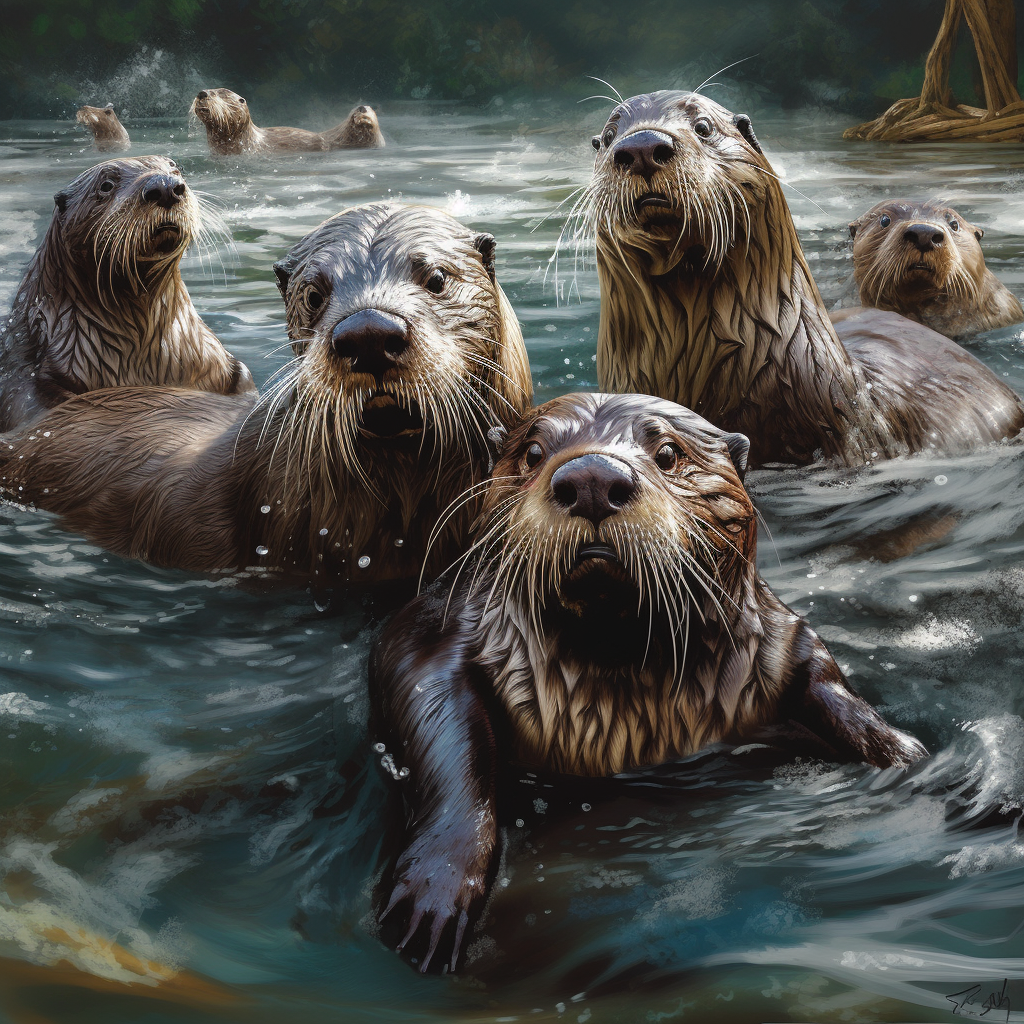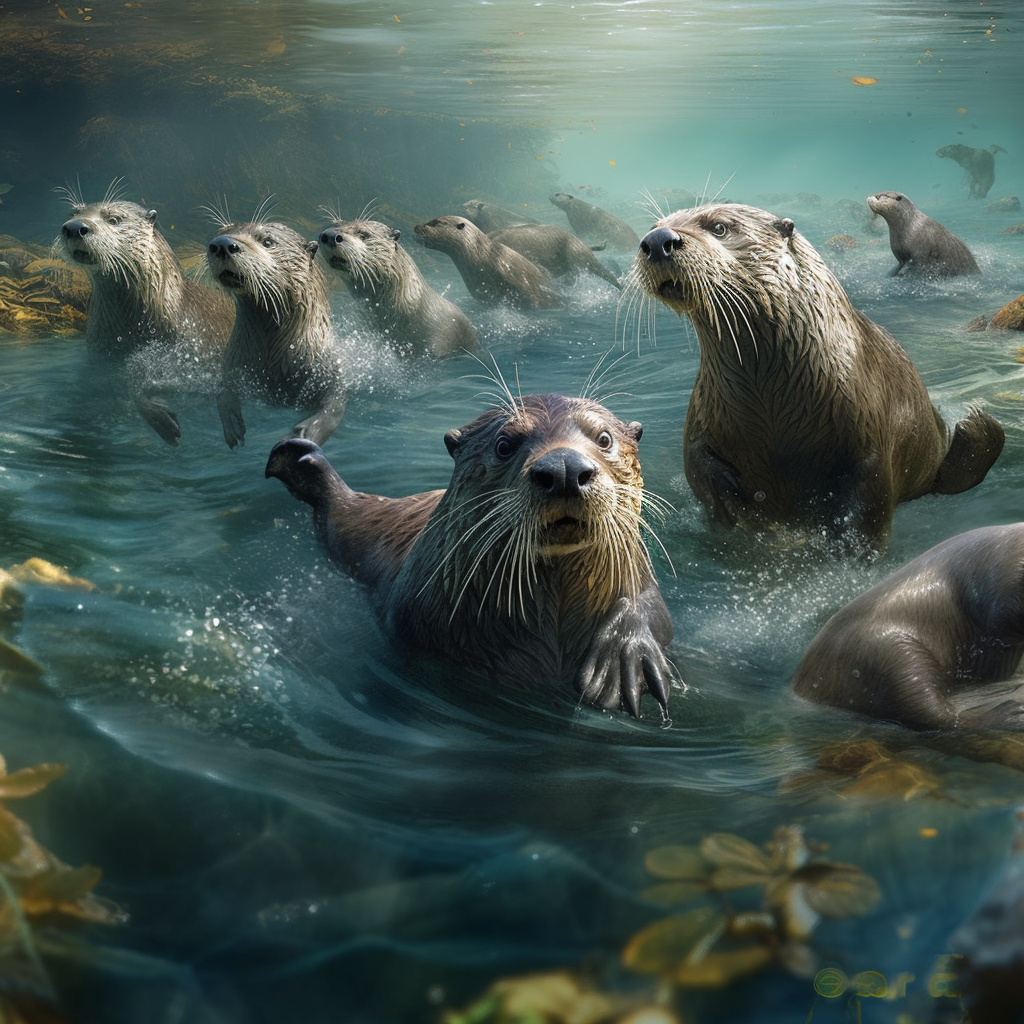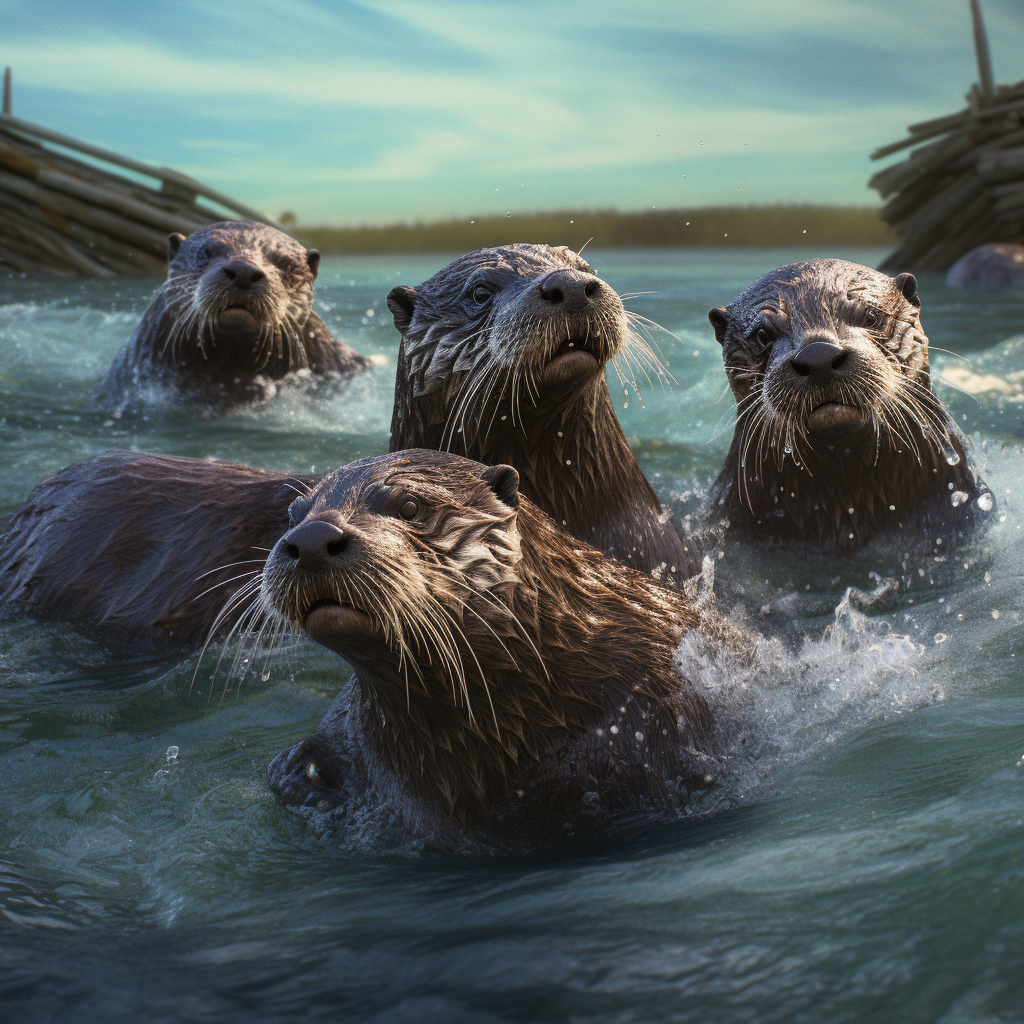Do River Otters Live in Groups?
River otters, scientifically known as Lontra canadensis, are fascinating creatures that inhabit various waterways across North America. These sleek and playful mammals are well-known for their excellent swimming abilities and playful nature. One question that often arises when discussing river otters is whether they live in groups or prefer a solitary lifestyle. In this article, we will explore the social behavior of river otters and shed light on whether they are solitary animals or if they indeed live in groups. So, let’s dive in and discover the fascinating world of river otters!
Key Takeaways
- River otters are social animals and often live in groups called romps.
- Romps can consist of several otters, including adults and their offspring.
- Living in groups provides benefits such as increased protection, hunting success, and social interaction.
- River otters communicate through vocalizations, scent marking, and body language within their groups.
- While river otters are generally social, they can also be solitary at times, especially during the breeding season.
The Natural Habitat of River Otters

River otters are fascinating creatures that are well adapted to their natural habitat. Let’s explore the rivers inhabited by otters and their global distribution.
A. Rivers Inhabited by Otters
River otters are primarily found in freshwater habitats such as rivers, streams, lakes, and wetlands. They are highly adaptable and can thrive in a variety of environments, from coastal areas to inland waterways. These playful creatures are excellent swimmers and rely on water bodies for their survival.
In North America, river otters can be found in numerous rivers and water systems, including the Mississippi River, the Colorado River, the Columbia River, and the Great Lakes region. They are also present in various Canadian provinces, such as British Columbia, Ontario, and Quebec.
In Europe, otters can be found in rivers like the Danube, the Rhine, and the Thames. They are also found in parts of Asia, including the Amur River in Russia and the Ganges River in India. These water bodies provide an abundant food supply and suitable shelter for otters to thrive.
B. Global Distribution of River Otters
River otters have a wide global distribution, with different species found in various parts of the world. In North America, the North American river otter (Lontra canadensis) is the most common species. They can be found across the continent, from Alaska to Florida.
In Europe, the Eurasian otter (Lutra lutra) is the native species. They are found in countries such as the United Kingdom, France, Germany, and Norway. The Eurasian otter has made a remarkable recovery in recent years after facing significant population declines due to pollution and habitat loss.
Other species of river otters can be found in different regions. The smooth-coated otter (Lutrogale perspicillata) is found in parts of Asia, including India, Bangladesh, and Southeast Asia. The giant otter (Pteronura brasiliensis) is native to South America, particularly the Amazon River basin.
It’s important to note that while river otters are widespread, their populations can vary in different regions due to factors such as habitat availability, water quality, and human activities. Conservation efforts are crucial to ensure the long-term survival of these charismatic creatures.
In conclusion, river otters are highly adaptable and can be found in a variety of freshwater habitats around the world. Their ability to live in groups allows them to socialize, hunt, and raise their young together. Understanding their natural habitat and global distribution is essential for conservation efforts and ensuring the well-being of these remarkable creatures.
The Social Structure of River Otters

A. Do River Otters Live in Groups?
River otters are highly social animals that often live in groups known as “rafts” or “romps.” These groups can consist of anywhere from two to twenty individuals, depending on the availability of resources and the size of the habitat. River otters are found in various parts of North America, including rivers, lakes, and coastal areas.
Living in groups offers several advantages for river otters. Firstly, it provides them with increased protection against predators. By staying together, otters can watch out for each other and defend against potential threats. Additionally, living in groups allows otters to share information about food sources and hunting techniques, which can improve their chances of survival.
B. The Benefits of Group Living for River Otters
Group living provides numerous benefits for river otters. One of the main advantages is the ability to defend territory. Otters mark their territories with scent, and by living in groups, they can collectively protect their space from intruders. This territorial defense is crucial for ensuring a stable food supply and breeding opportunities.
Another benefit of group living is the opportunity for social interaction. River otters are highly social animals that engage in playful behaviors, such as sliding down muddy slopes or engaging in mock fights. Living in groups allows otters to socialize and bond with one another, which is important for their overall well-being.
Furthermore, group living enhances the chances of successful reproduction. Female otters within a group often synchronize their estrous cycles, which increases the likelihood of mating and successful reproduction. Additionally, group members can assist in raising and protecting the young, ensuring their survival.
C. How River Otters Communicate in Groups
River otters have a complex system of communication within their groups. They use a combination of vocalizations, body postures, and scent marking to convey messages to one another. Some common vocalizations include chirps, whistles, and growls.
Scent marking is an essential form of communication for river otters. They have scent glands near their tails, which they use to mark their territories and communicate their presence to other otters. By leaving scent marks, otters can convey information about their identity, reproductive status, and territory boundaries.
In addition to vocalizations and scent marking, river otters also use body postures to communicate. For example, an otter may arch its back and raise its tail as a sign of aggression, while a relaxed and playful posture indicates a friendly interaction.
Overall, the social structure of river otters is fascinating and plays a crucial role in their survival and well-being. Living in groups provides them with protection, social interaction, and reproductive advantages. Through their complex communication methods, otters are able to maintain strong bonds and navigate their social dynamics effectively.
The Travelling Patterns of River Otters

A. Do River Otters Travel in Groups?
River otters are highly social animals and often live in groups called “holts” or “rafts.” These groups consist of several individuals, typically related to each other. Living in groups provides several benefits for river otters, including increased protection, improved hunting success, and enhanced social interaction.
River otters are known for their playful and curious nature, and living in groups allows them to engage in social activities such as grooming, playing, and communicating with each other. These interactions help strengthen the bonds within the group and contribute to the overall well-being of the otters.
B. How Distance and Destination Influence Group Travel
The distance and destination play a significant role in determining how river otters travel in groups. When traveling short distances within their home range, otters may choose to travel alone or in small family groups. These family groups typically consist of a female otter, her offspring from the current and previous years, and occasionally a male otter.
However, when river otters need to travel longer distances or venture into new territories, they often form larger groups. These groups can include multiple families or individuals from different families. By traveling in larger groups, otters can provide each other with protection and support during unfamiliar journeys.
River otters are excellent swimmers and can cover long distances in search of food or suitable habitats. They are known to travel along rivers, lakes, and coastlines, using these waterways as their highways. When traveling in groups, otters can also benefit from the collective knowledge and experience of the group members, making it easier to find food and navigate through unfamiliar territories.
In summary, river otters are social animals that often live in groups. These groups provide various advantages, including protection, improved hunting success, and social interaction. The size of the group can vary depending on the distance and destination of the journey. Whether traveling alone, in small family groups, or larger groups, river otters exhibit fascinating social behaviors that contribute to their overall survival and well-being.
Comparing River Otters to Other Otter Species
A. Do Other Otter Species Live in Groups?
River otters are fascinating creatures known for their playful nature and social behavior. But what about other otter species? Do they also live in groups? Let’s take a closer look at some other otter species and see how their social structures compare to that of river otters.
1. Sea Otters
Sea otters, unlike river otters, are known to be more solitary in their lifestyle. They typically live alone or in small family groups consisting of a mother and her offspring. These family groups are transient and can change over time as the young otters grow up and venture off on their own. However, sea otters do exhibit some social behavior when they come together during mating season or while resting in groups called “rafts” on the water’s surface.
2. Giant Otters
Giant otters, native to South America, are highly social animals that live in large family groups. These groups, known as “holts,” consist of an alpha breeding pair and their offspring from different generations. The alpha pair is responsible for leading and protecting the group, while the other members help with hunting, grooming, and caring for the young. Giant otters are known for their vocalizations, which they use to communicate within their group and establish territory boundaries.
3. Asian Small-Clawed Otters
Asian small-clawed otters are another species that live in groups. They form monogamous pairs and live in extended family groups consisting of the breeding pair and their offspring. These groups can range in size from a few individuals to up to 15 otters. Asian small-clawed otters are highly social and engage in cooperative behaviors such as grooming each other and vocalizing to communicate within the group.
B. Comparing Habitats: Do Other Otters Live in Rivers?
River otters are well adapted to life in and around freshwater habitats, but what about other otter species? Do they also inhabit rivers?
1. Sea Otters
Sea otters, as their name suggests, primarily inhabit coastal marine environments such as oceans, bays, and estuaries. They rely on kelp forests for shelter and protection from predators. While they may occasionally venture into freshwater areas, they are not as well adapted to river habitats as river otters.
2. Giant Otters
Giant otters, on the other hand, are well suited for life in rivers and freshwater habitats. They are found in the Amazon basin and other freshwater ecosystems in South America. These otters are excellent swimmers and have webbed feet and a streamlined body that allows them to navigate through rivers with ease. They build dens along riverbanks and rely on fish as their primary food source.
3. Asian Small-Clawed Otters
Asian small-clawed otters are also well adapted to both freshwater and coastal habitats. They can be found in various regions of Southeast Asia, including rivers, mangrove swamps, and coastal areas. These otters have partially webbed feet and sharp claws, which they use to catch prey in water and on land.
In conclusion, while river otters are known for their group living behavior, other otter species exhibit a range of social structures. Sea otters tend to be more solitary, while giant otters and Asian small-clawed otters live in family groups. Additionally, while river otters are well adapted to river habitats, sea otters primarily inhabit coastal marine environments, and giant otters and Asian small-clawed otters can be found in both freshwater and coastal habitats. Each otter species has its own unique adaptations and social dynamics that contribute to their survival and success in their respective habitats.
Conclusion
In conclusion, river otters are highly social animals that typically live in groups called “rafts.” These rafts consist of family members, including a dominant breeding pair and their offspring. Living in groups provides several benefits to river otters, such as increased protection from predators, improved hunting success, and enhanced social interactions. River otters are known for their playful nature and strong family bonds, which are fostered through group living. While they are primarily social animals, river otters can also be solitary at times, especially during the breeding season. Overall, the group dynamics of river otters contribute to their survival and thriving in their aquatic habitats.
Frequently Asked Questions
What rivers do otters live in?
River otters inhabit a variety of water habitats, including rivers, streams, lakes, ponds, and marshes. They are found in water systems all over North America, Europe, and Asia. Some specific rivers where otters are known to live include the Amazon River, the Mississippi River, and the Hudson River.
Why do river otters live in groups?
River otters live in groups primarily for protection and socialization. Living in a group allows otters to better defend against predators and to hunt more efficiently. The social structure of otter groups also facilitates learning and play among young otters.
Do river otters travel in groups?
Yes, river otters often travel in groups, which are sometimes called romps. These groups are usually made up of family members, including a mother and her offspring. Traveling in groups allows otters to protect each other and hunt more effectively.
Do otters live in groups?
Yes, otters are social animals and typically live in groups. These groups, often called families or colonies, can range in size from just a few individuals to more than a dozen. The group usually consists of a female and her offspring, and sometimes includes unrelated individuals as well.
Where do river otters live?
River otters are found in a variety of aquatic habitats across North America, Europe, and Asia. They prefer clean, healthy water systems with plenty of food and cover. In addition to rivers, they can also be found in streams, lakes, ponds, and marshes.
Do river otters live in groups?
Yes, river otters are social animals and typically live in groups, often called families or colonies. These groups usually consist of a female and her offspring, and sometimes include unrelated individuals as well. Group living provides many benefits, including increased protection from predators and more efficient hunting.
Do otters live in rivers?
Yes, otters are semi-aquatic mammals and many species, including the river otter, live in rivers. However, otters can also be found in a variety of other aquatic habitats, including streams, lakes, ponds, and marshes.
What is the social behavior of otters?
Otters are social animals that typically live in groups called families or colonies. They engage in a variety of social behaviors, including play, grooming, and group hunting. Communication among otters involves a combination of vocalizations, body postures, and scent marking.
What is the family structure of otters?
The typical otter family consists of a female and her offspring. Males generally live alone or in groups with other males, and join female groups only for mating. After mating, the male leaves and the female raises the offspring on her own.
What is the group behavior of otters?
Otters exhibit a variety of group behaviors, including cooperative hunting, group play, and mutual grooming. They also communicate with each other through a combination of vocalizations, body postures, and scent marking. Group living provides many benefits for otters, including increased protection from predators and more efficient hunting.




